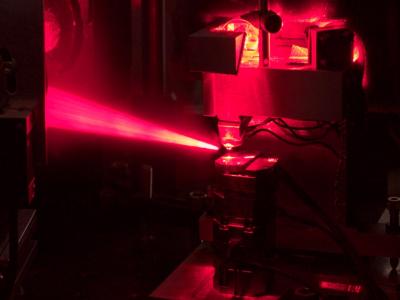Researchers consider quantum dots to hold great potential for technological applications. The nanoscale semiconductor materials are easy to synthesize and their behavior is akin to that of single atoms. In order to capitalize on the unique properties of quantum dots, it is essential to understand the behavior of electrons contained inside quantum dots.
 Near-field microscopy using the free electron laser at HZDR: An adjusting laser is employed to align the measuring tip of the microscope that comes from above. Below the movable sample stage is to be seen. Credit: HZDR
Near-field microscopy using the free electron laser at HZDR: An adjusting laser is employed to align the measuring tip of the microscope that comes from above. Below the movable sample stage is to be seen. Credit: HZDR
There are typically one or two electrons inside the pyramid-like nanostructure of quantum dots and their movements are severely restricted by the pyramid walls. The properties of a material are tied to the behavior of the electrons present in it.
Scientists from Helmholtz-Zentrum Dresden-Rossendorf (HZDR), the Leibniz Institute for solid State and Materials Research Dresden (IFW) and TU Dresden have succeeded in observing the special energy states occupied by electrons confined in quantum dots.
The restricted movement in quantum dots allows electrons to occupy specific energy levels depending upon the semiconductor material and the size of the pyramid. When the electrons fall from a higher to a lower energy level, they emit light. This principle is exploited in lasers based on quantum dots. The color of emitted light depends on the difference in the energy levels.
The researchers from Dresden hold the distinction of being the first in recent times to successfully image the electron transition between energy levels using infrared light. Since electrons in different sizes of nanopyramids respond to different infrared energies, it is possible to obtain only blurred signals by using infrared light. For this reason, it becomes significant to view the electrons confined to a single quantum dot. The researchers achieved this by using scanning near-field microscopy. The technique is sensitive enough to generate a distinct nanosized image of the electrons inside a quantum dot.